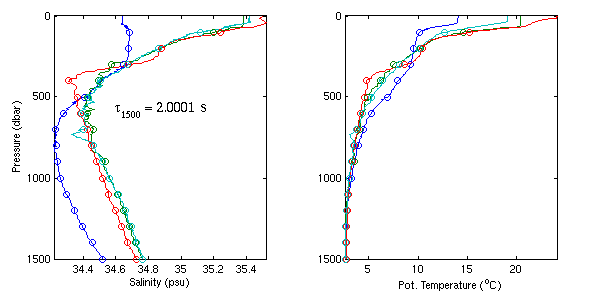

Figure 2. Sample of Cape Basin hydrography. All of the hydrocasts above have the same acoustic travel time, and these water columns would be indistinguishable from one another if measured solely with an inverted echo sounder (IES) mooring. The same kind of uncertainty plagues measurements of altimetric sea level.
GEM-ETTA, a combination of the Gravest Empirical Mode [Watts et al., 2001] and Enhanced Thermohaline Transport Analysis [Byrne, 2000]) methods, uses several independent information sources to help ascribe thermohaline signatures to the observed variability. The principal sources of information are pressure/inverted echo sounder (PIES) moorings and satellite altimetry.
ASTTEX Future Work: In late 2002-early 2003, the field component of ASTTEX will begin. The field experiment includes twelve PIES, three acoustic current meter (CM) moorings, and one validation mooring that will record in situ temperature and salinity at six depths. The mooring deployment will last for 24 months. In addition, a 13-year monthly timeseries of large-scale sea level patterns will be created using TOPEX/POSEIDON and Jason-1 altimetry. This measurement of low-frequency variability will be used to provide a regional context for the in situ measurements. Agulhas and SAMW eddies visible in the altimetric record will also be tracked for the entire period from the beginning of the BEST field experiment to the end of the ASTTEX deployment. Both of these relatively long altimetric timeseries will help determine to what extent conditions during the field experiment resemble those of other years.
ASTTEX Retrospective Work: The field component of the BEST (Benguela Sources and Transport) project in late 1992-1993 included the deployment of a number of inverted echo sounders in the Cape Basin [Garzoli and Gordon, 1996; Garzoli et al., 1996; Duncombe Rae et al., 1996]. In this work, we apply the GEM-ETTA method to the BEST mooring data. While the distance between the BEST IES moorings is too great to resolve most mesoscale components of the flow, the larger-scale thermohaline fluxes through a substantial fraction of the Cape Basin can be determined. These transports will later be compared with equivalent ones from ASTTEX to obtain a first-order estimate of the decadal-scale variability of the Agulhas-South Atlantic fluxes.